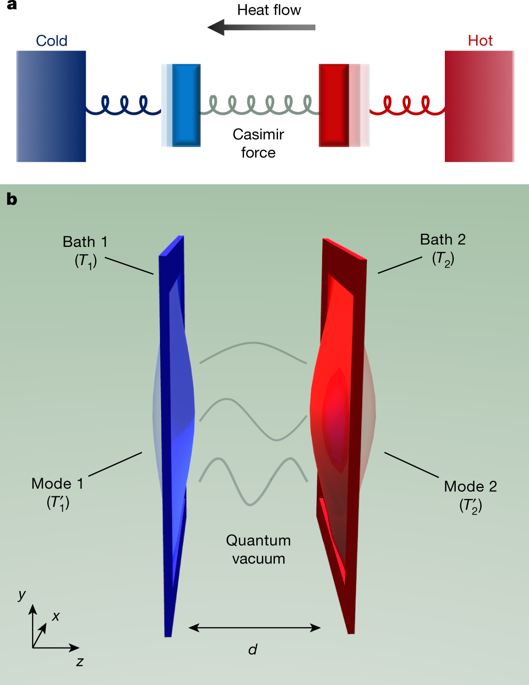Our official English website, www.x-mol.net, welcomes your
feedback! (Note: you will need to create a separate account there.)
Phonon heat transfer across a vacuum through quantum fluctuations
Nature ( IF 50.5 ) Pub Date : 2019-12-11 , DOI: 10.1038/s41586-019-1800-4 King Yan Fong 1 , Hao-Kun Li 1 , Rongkuo Zhao 1 , Sui Yang 1 , Yuan Wang 1 , Xiang Zhang 1, 2
Nature ( IF 50.5 ) Pub Date : 2019-12-11 , DOI: 10.1038/s41586-019-1800-4 King Yan Fong 1 , Hao-Kun Li 1 , Rongkuo Zhao 1 , Sui Yang 1 , Yuan Wang 1 , Xiang Zhang 1, 2
Affiliation

|
Heat transfer in solids is typically conducted through either electrons or atomic vibrations known as phonons. In a vacuum, heat has long been thought to be transferred by radiation but not by phonons because of the lack of a medium1. Recent theory, however, has predicted that quantum fluctuations of electromagnetic fields could induce phonon coupling across a vacuum and thereby facilitate heat transfer2–4. Revealing this unique quantum effect experimentally would bring fundamental insights to quantum thermodynamics5 and practical implications to thermal management in nanometre-scale technologies6. Here we experimentally demonstrate heat transfer induced by quantum fluctuations between two objects separated by a vacuum gap. We use nanomechanical systems to realize strong phonon coupling through vacuum fluctuations, and observe the exchange of thermal energy between individual phonon modes. The experimental observation agrees well with our theoretical calculations and is unambiguously distinguished from other effects such as near-field radiation and electrostatic interaction. Our discovery of phonon transport through quantum fluctuations represents a previously unknown mechanism of heat transfer in addition to the conventional conduction, convection and radiation. It paves the way for the exploitation of quantum vacuum in energy transport at the nanoscale. Conventionally, heat transfer occurs by conduction, convection or radiation, but has also been theoretically predicted to occur through quantum fluctuations across a vacuum; this prediction has now been confirmed experimentally.
中文翻译:

通过量子涨落穿过真空的声子热传递
固体中的传热通常通过电子或称为声子的原子振动进行。在真空中,由于缺乏介质,长期以来人们一直认为热量是通过辐射而不是声子传递的。然而,最近的理论预测,电磁场的量子涨落可以在真空中引起声子耦合,从而促进热传递 2-4。通过实验揭示这种独特的量子效应将为量子热力学5带来基本的见解,并对纳米级技术的热管理产生实际影响6。在这里,我们通过实验证明了由真空间隙隔开的两个物体之间的量子涨落引起的热传递。我们使用纳米机械系统通过真空涨落实现强声子耦合,并观察各个声子模式之间的热能交换。实验观察结果与我们的理论计算非常吻合,并且明确地区分于其他效应,如近场辐射和静电相互作用。除了传统的传导、对流和辐射之外,我们通过量子涨落发现的声子传输代表了一种以前未知的传热机制。它为在纳米尺度的能量传输中利用量子真空铺平了道路。传统上,热传递通过传导、对流或辐射发生,但理论上也预测通过真空中的量子涨落发生;这一预测现在已经通过实验得到证实。实验观察结果与我们的理论计算非常吻合,并且明确地区分于其他效应,如近场辐射和静电相互作用。除了传统的传导、对流和辐射之外,我们通过量子涨落发现的声子传输代表了一种以前未知的传热机制。它为在纳米尺度的能量传输中利用量子真空铺平了道路。传统上,热传递通过传导、对流或辐射发生,但理论上也预测通过真空中的量子涨落发生;这一预测现在已经通过实验得到证实。实验观察结果与我们的理论计算非常吻合,并且明确地区分于其他效应,如近场辐射和静电相互作用。除了传统的传导、对流和辐射之外,我们通过量子涨落发现的声子传输代表了一种以前未知的传热机制。它为在纳米尺度的能量传输中利用量子真空铺平了道路。传统上,热传递通过传导、对流或辐射发生,但理论上也预测通过真空中的量子涨落发生;这一预测现在已经通过实验得到证实。除了传统的传导、对流和辐射之外,我们通过量子涨落发现的声子传输代表了一种以前未知的传热机制。它为在纳米尺度的能量传输中利用量子真空铺平了道路。传统上,热传递通过传导、对流或辐射发生,但理论上也预测通过真空中的量子涨落发生;这一预测现在已经通过实验得到证实。除了传统的传导、对流和辐射之外,我们通过量子涨落发现的声子传输代表了一种以前未知的传热机制。它为在纳米尺度的能量传输中利用量子真空铺平了道路。传统上,热传递通过传导、对流或辐射发生,但理论上也预测通过真空中的量子涨落发生;这一预测现在已经通过实验得到证实。对流或辐射,但理论上也预测会通过真空中的量子涨落发生;这一预测现在已经通过实验得到证实。对流或辐射,但理论上也预测会通过真空中的量子涨落发生;这一预测现在已经通过实验得到证实。
更新日期:2019-12-11
中文翻译:

通过量子涨落穿过真空的声子热传递
固体中的传热通常通过电子或称为声子的原子振动进行。在真空中,由于缺乏介质,长期以来人们一直认为热量是通过辐射而不是声子传递的。然而,最近的理论预测,电磁场的量子涨落可以在真空中引起声子耦合,从而促进热传递 2-4。通过实验揭示这种独特的量子效应将为量子热力学5带来基本的见解,并对纳米级技术的热管理产生实际影响6。在这里,我们通过实验证明了由真空间隙隔开的两个物体之间的量子涨落引起的热传递。我们使用纳米机械系统通过真空涨落实现强声子耦合,并观察各个声子模式之间的热能交换。实验观察结果与我们的理论计算非常吻合,并且明确地区分于其他效应,如近场辐射和静电相互作用。除了传统的传导、对流和辐射之外,我们通过量子涨落发现的声子传输代表了一种以前未知的传热机制。它为在纳米尺度的能量传输中利用量子真空铺平了道路。传统上,热传递通过传导、对流或辐射发生,但理论上也预测通过真空中的量子涨落发生;这一预测现在已经通过实验得到证实。实验观察结果与我们的理论计算非常吻合,并且明确地区分于其他效应,如近场辐射和静电相互作用。除了传统的传导、对流和辐射之外,我们通过量子涨落发现的声子传输代表了一种以前未知的传热机制。它为在纳米尺度的能量传输中利用量子真空铺平了道路。传统上,热传递通过传导、对流或辐射发生,但理论上也预测通过真空中的量子涨落发生;这一预测现在已经通过实验得到证实。实验观察结果与我们的理论计算非常吻合,并且明确地区分于其他效应,如近场辐射和静电相互作用。除了传统的传导、对流和辐射之外,我们通过量子涨落发现的声子传输代表了一种以前未知的传热机制。它为在纳米尺度的能量传输中利用量子真空铺平了道路。传统上,热传递通过传导、对流或辐射发生,但理论上也预测通过真空中的量子涨落发生;这一预测现在已经通过实验得到证实。除了传统的传导、对流和辐射之外,我们通过量子涨落发现的声子传输代表了一种以前未知的传热机制。它为在纳米尺度的能量传输中利用量子真空铺平了道路。传统上,热传递通过传导、对流或辐射发生,但理论上也预测通过真空中的量子涨落发生;这一预测现在已经通过实验得到证实。除了传统的传导、对流和辐射之外,我们通过量子涨落发现的声子传输代表了一种以前未知的传热机制。它为在纳米尺度的能量传输中利用量子真空铺平了道路。传统上,热传递通过传导、对流或辐射发生,但理论上也预测通过真空中的量子涨落发生;这一预测现在已经通过实验得到证实。对流或辐射,但理论上也预测会通过真空中的量子涨落发生;这一预测现在已经通过实验得到证实。对流或辐射,但理论上也预测会通过真空中的量子涨落发生;这一预测现在已经通过实验得到证实。




















































 京公网安备 11010802027423号
京公网安备 11010802027423号